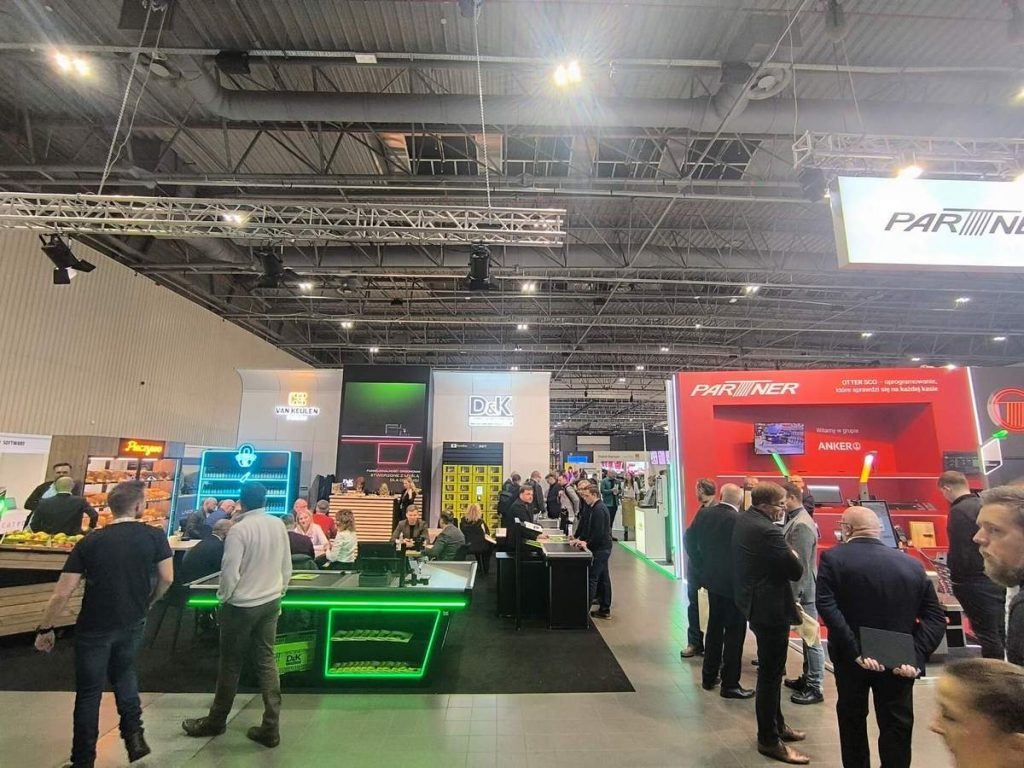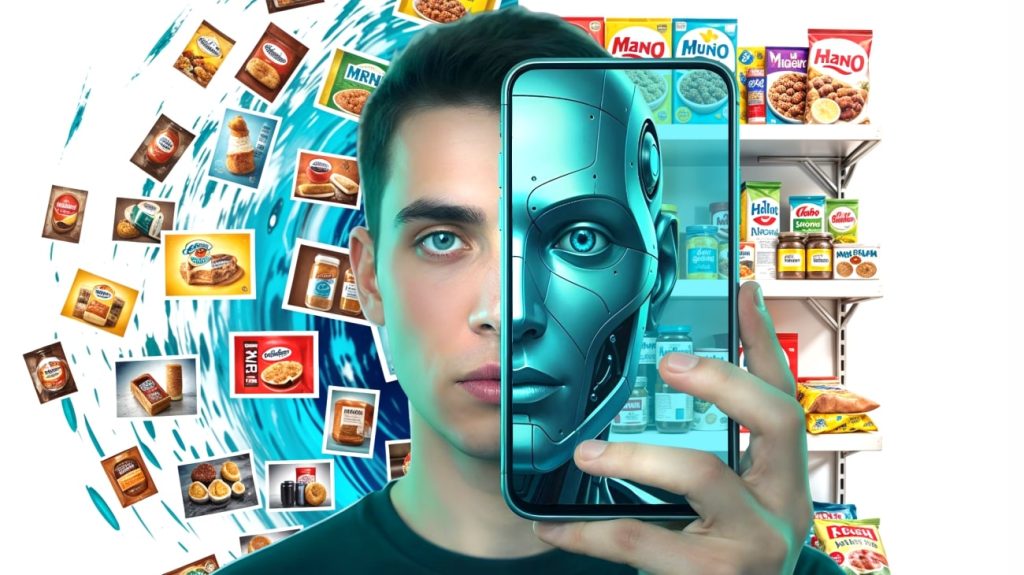The retail industry has undergone a profound metamorphosis in recent years, fueled by technological innovations that are constantly redefining the shopping experience. Computer vision stands out as one of a transformative force. It is reshaping the way retailers engage with customers, manage operations, and thrive in an increasingly digital world.
Continue reading this piece to join retail automation experts from IBA Group as they uncover the benefits of computer vision in the retail landscape.
Table of Сontents
- First, What Is Computer Vision?
- Importance of Computer Vision in the Retail Industry
- Brief History of Computer Vision in Retail
- Current Applications and Trends
- Future Prospects
- In-Store Computer Vision
- E-commerce
- Challenges and Ethical Considerations
- Case Studies
- Importance of Staying Ahead in a Competitive Market
- Opportunities for Growth and Innovation
- Recap of the Impact of Computer Vision
- Conclusion
First, What Is Computer Vision?

Computer vision is a revolutionary branch of artificial intelligence (AI). It is the science of teaching machines to “see” and interpret visual information from the environment. It equips machines with the ability to recognize patterns, objects, and even complex scenes through the analysis of images or video streams. Computer vision allows machines to comprehend the world in ways previously thought to be the sole domain of humans.
The applications of computer vision are vast and diverse.
- Self-Driving Cars: navigating through bustling city streets autonomously.
- Medical Imaging: aiding doctors in diagnosing diseases and medical conditions.
- Facial Recognition: enabling biometric authentication for security purposes.
- Augmented Reality: creating immersive experiences blending virtual and real worlds seamlessly.
- Surveillance Systems: implementing sophisticated security measures for enhanced safety.
Importance of Computer Vision in the Retail Industry
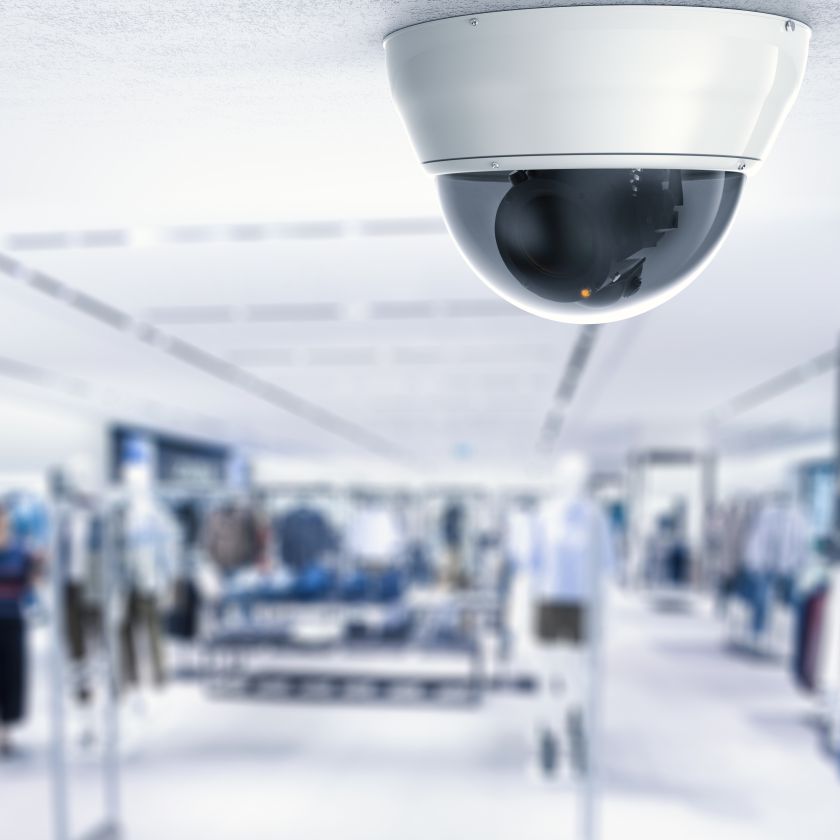
In the dynamic landscape of the retail industry, where customer experience and operational efficiency reign supreme, computer vision has emerged as a transformative force. Computer vision offers a broad range of applications in retail. From optimizing inventory management to revolutionizing customer interactions and marketing strategies, its versatility addresses various challenges faced by retailers.
For example, automated checkout systems and cashier-less stores streamline the shopping process, reducing waiting times and eliminating friction. Moreover, computer vision-driven analytics empower retailers to develop targeted marketing strategies. By reaching specific customer segments with personalized promotions and product recommendations, retailers can boost customer engagement and foster long-term loyalty.
Brief History of Computer Vision in Retail
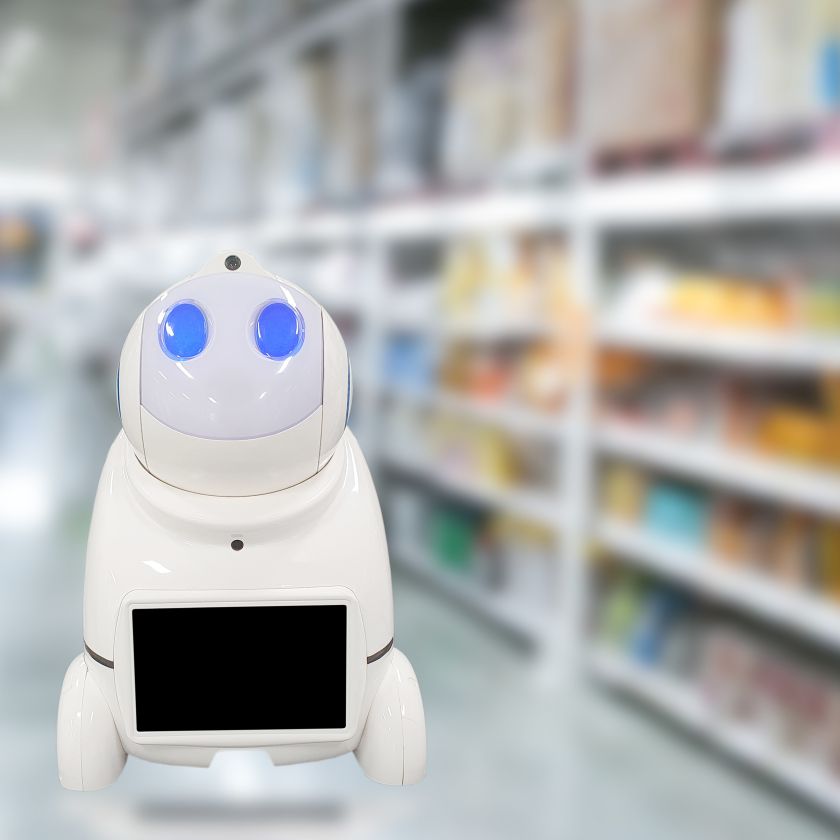
Computer vision in retail traces back to the early 1990s when the concept of automating certain tasks through machine vision began to take root. It started with barcode scanners automating product identification and pricing at checkout.
This marked the initial foray of computer vision technology into retail environments, setting the stage for more profound innovations to come.In the following decades, advances in hardware and algorithms allowed retailers to understand customer behavior using surveillance cameras..
In the 21st century, deep learning and neural networks, like Convolutional Neural Networks (CNNs), greatly improved image recognition. Retailers embraced this tech for security and understanding customer preferences.
Nowadays, smart cameras and sensors are used to gather data in physical stores, optimizing layouts and tailoring marketing strategies. E-commerce platforms also benefit from computer vision, enhancing visual search for customers.
Current Applications and Trends
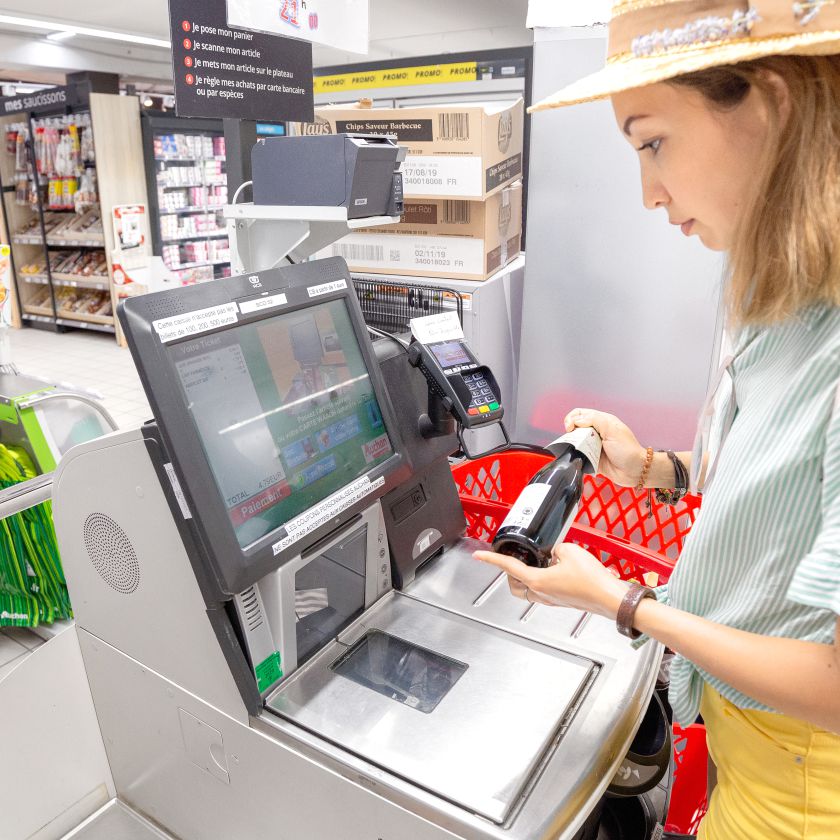
In the present retail landscape, computer vision has evolved into a diverse and powerful tool.It offers a wide array of applications that redefine customer experiences, streamline operations, and drive business growth.
Several types of computer vision applications have gained prominence in the retail industry. Each of these applications has the potential to revolutionize the way retailers operate and connect with their customers.
- Customer Analytics: Computer vision is extensively utilized to analyze customer behavior in physical stores. Smart cameras and sensors track foot traffic, dwell times, and customer interactions with products. Retailers leverage this data to optimize store layouts, design targeted marketing strategies, and enhance overall customer engagement.
- Personalized Marketing: With computer vision, retailers can offer personalized recommendations to their customers. These recommendations are based on their browsing and purchase history. Analyzing visual data from previous interactions allows retailers to present targeted promotions and product suggestions. Ultimately, it enhances the chances of conversion and fostering brand loyalty.
- Inventory Management: Accurate inventory management is vital for retailers to meet customer demands while minimizing costs. Computer vision technology allows for real-time monitoring of stock levels, enabling timely restocking and reducing the risk of stockouts or overstocking.
- Cashierless Checkout: Lately, automated checkout systems powered by computer vision have gained popularity in cashier-less stores. Customers can simply pick up their desired items and leave the store – computer vision tracks their selections and processes payments seamlessly.
As computer vision technology continues to advance, its potential impact on the retail industry is boundless. By embracing these applications and trends, retailers can thrive in an increasingly competitive market, offering customers innovative and personalized shopping experiences.
Future Prospects
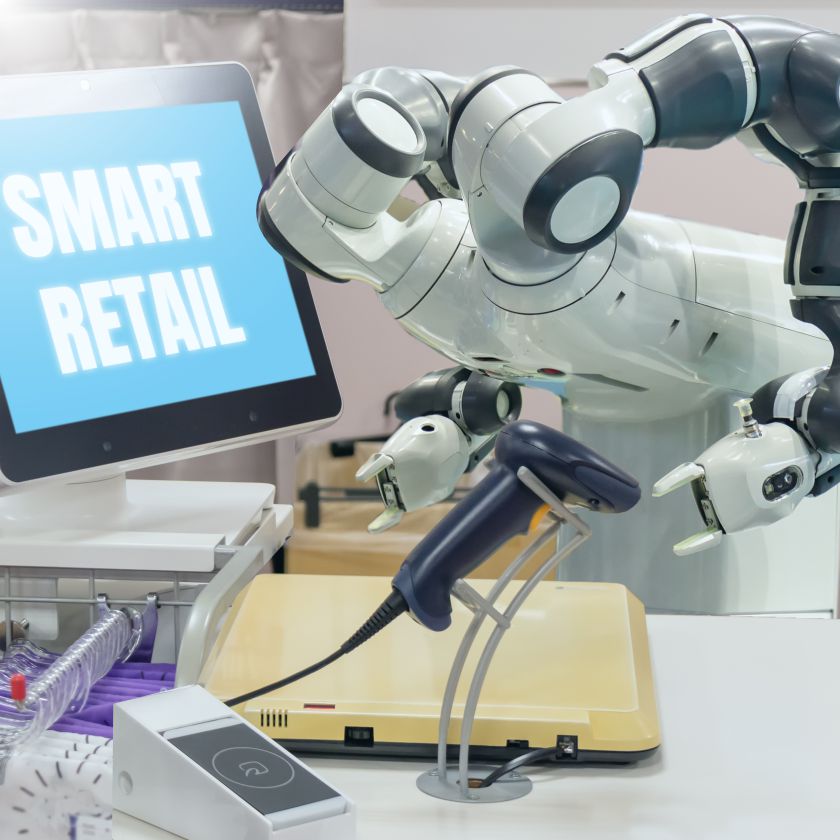
The future prospects of computer vision in the retail industry are nothing short of transformative, promising to revolutionize the way consumers shop and retailers operate. As technology advances and AI-driven innovations become more sophisticated, computer vision’s role in shaping the retail landscape is poised to grow. Its impact will be increasingly pivotal in revolutionizing the industry.
- Enhanced Customer Experience: Computer vision will help retailers offer hyper-personalized shopping experiences by analyzing large amounts of customer data. Smart cameras and AI algorithms will seamlessly integrate with mobile apps and online platforms, providing tailored product recommendations, virtual try-ons, and AR-enhanced shopping journeys.
- Frictionless Checkout: The future of computer vision in retail revolves around perfecting cashier-less and checkout-free stores. Advanced computer vision systems will track customer selections and purchases accurately, enabling seamless transactions without traditional checkout counters.
- Smart Store Layouts: Retailers will utilize computer vision to optimize store layouts dynamically. Real-time data analysis will enable them to adapt store designs based on customer traffic patterns, improving product placement and customer flow.
- Inventory and Supply Chain Optimization: Computer vision will be instrumental in revolutionizing inventory management and supply chain logistics. Retailers will have a real-time view of stock levels, demand trends, and shelf restocking needs. It will help minimize stockouts and reduce inventory costs.
- Behavioral Analysis and Market Insights. Retailers will gain deeper insights into consumer behavior by employing advanced computer vision algorithms to analyze shopping patterns, preferences, and emotions. This data-driven approach will inform marketing strategies, leading to more effective and targeted campaigns.
- Retail Security and Loss Prevention: Computer vision will continue to strengthen retail security measures through improved surveillance and facial recognition technologies, enhancing loss prevention efforts and deterring potential threats.
- Social Commerce: With the rise of social media shopping, computer vision will facilitate seamless product discovery and purchasing. Customers will be able to shop directly from social media platforms using visual search and AR features.
Computer vision in retail will drive innovation and growth in the future. By blending the physical and digital realms, it will create a unique shopping experience, redefining how consumers engage with brands and revolutionizing the retail industry.
In-Store Computer Vision
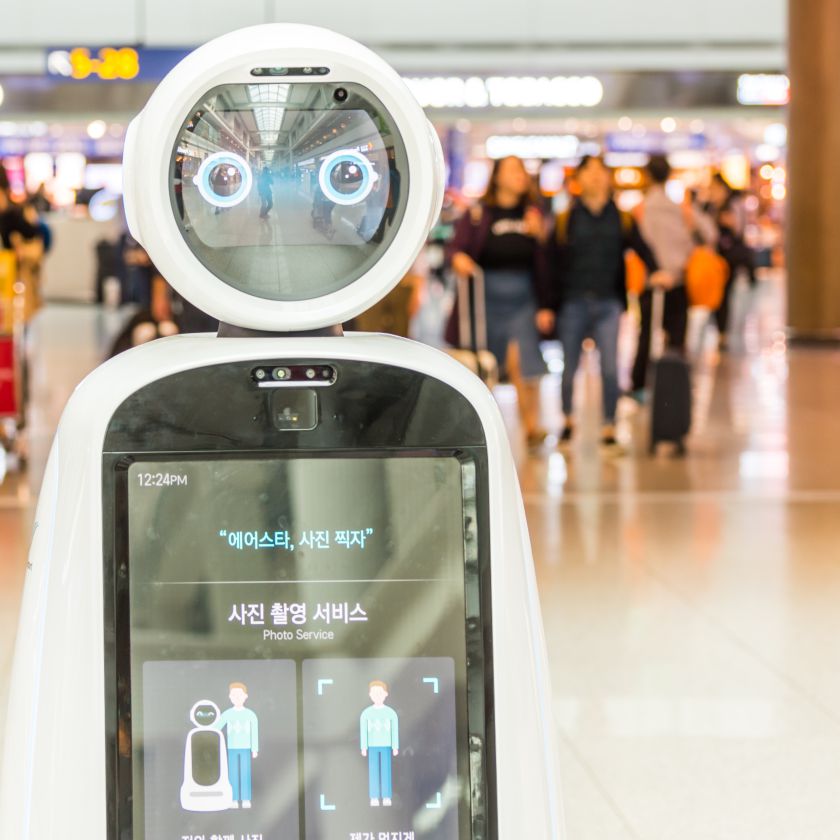
In-store computer vision in retail has three valuable applications. First, it revolutionizes inventory management by providing real-time data on stock levels, optimizing restocking decisions, and reducing stockouts. Second, it serves as a powerful tool for theft prevention, using advanced surveillance and facial recognition to deter and identify potential shoplifters. Lastly, computer vision enhances customer engagement by analyzing shopping patterns and preferences, enabling personalized experiences through targeted promotions and recommendations, ultimately fostering long-lasting brand loyalty. This technology empowers retailers to create seamless and secure in-store environments while delivering tailored experiences that leave a lasting impact on customers.

Inventory Management Applications
Computer vision’s inventory management applications in retail revolutionize product tracking and management. Smart cameras and sensors provide real-time data on stock levels, helping retailers monitor inventory accurately. Automated systems detect low-stock situations, trigger restocking alerts, and minimize overstocking, optimizing inventory turnover and reducing costs. By streamlining inventory processes, computer vision improves supply chain logistics, product availability, and the shopping experience. This technology empowers retailers to maintain optimal stock levels, maximize revenue potential, and eliminate manual inventory inefficiencies.
Stock Tracking
Computer vision’s stock tracking application in the retail industry revolutionizes inventory management. Smart cameras and sensors placed strategically in the store monitor stock levels and product movements in real-time.
The process involves smart cameras continuously capturing visual data of product shelves and storage areas. Advanced computer vision algorithms then analyze the data, identifying changes in stock quantities and tracking item movement. Retailers can access this information through intuitive dashboards and analytics platforms.
Stock tracking using computer vision offers numerous benefits. Firstly, it ensures accurate and up-to-date inventory information, reducing the risk of stockouts or overstocking. Timely alerts enable swift restocking decisions, optimizing inventory levels and cash flow.
Supply chain efficiency improves as retailers can plan orders better, reducing lead times and satisfying customer demands. Minimizing manual errors in inventory management allows human resources to focus on strategic aspects of the business.
Seamless integration of this technology makes store operations agile and responsive to customer demands, enhancing overall operational efficiency. This all contributes to improved customer satisfaction and a more successful retail business.
Shelf Management
Shelf management application driven by computer vision holds immense usefulness in optimizing product placement and enhancing overall store efficiency.
Optimizing Product Placement with Computer Vision
Shelf management applications driven by computer vision offer immense usefulness in optimizing product placement and store efficiency. Smart cameras and sensors monitor and analyze product shelves in real-time, ensuring optimal organization and stocking.
Enhancing Visual Merchandising
Computer vision algorithms process visual data, identifying shelf conditions, product positioning, and stock levels. Retailers gain insights into shelf organization and planogram compliance, creating visually appealing and engaging displays to attract customers and increase sales.
Accurate Stock Tracking and Prompt Restocking
Computer vision-driven shelf management helps track stock levels accurately. Real-time detection of low-stock situations enables prompt restocking, minimizing stockouts and ensuring customers find the products they need.
Improving Inventory Accuracy
Computer vision reduces manual errors in stock tracking, improving inventory accuracy and minimizing discrepancies between actual stock levels and recorded data.
Data-Driven Decisions and Customer Satisfaction
By analyzing customer interactions with shelves, retailers gain insights into product popularity and performance, informing future inventory and marketing decisions. This data-driven approach enhances customer satisfaction and loyalty.
Empowering Retailers for Success
Computer vision-powered shelf management empowers retailers to optimize product displays, maintain efficient stock levels, and provide an exceptional shopping experience. By leveraging this technology, retailers can boost sales, reduce operational inefficiencies, and gain a competitive edge in the dynamic retail landscape.
Automated Replenishment
Automated replenishment, a highly valuable inventory management application, streamlines the restocking process, ensuring that shelves are well-stocked and products are readily available for customers.
Streamlining Restocking with Automated Replenishment
Automated replenishment is a valuable inventory management application that streamlines the restocking process, ensuring shelves are well-stocked for customers. Smart cameras and sensors monitor stock levels in real-time, triggering automated replenishment workflows.
Efficient Process with Computer Vision
Smart cameras continuously capture visual data of product shelves, and advanced computer vision algorithms analyze this data to determine stock levels. When stock falls below predefined thresholds, automated alerts prompt the replenishment process.
Ensuring Product Availability and Customer Satisfaction
Automated replenishment minimizes stockouts, ensuring customers find the products they need. This leads to enhanced customer satisfaction and loyalty.
Optimizing Inventory Management
Automated replenishment reduces excess stock and carrying costs, helping retailers maintain optimal stock levels and eliminate manual stock checks. It also reduces the risk of overstocking.
Improving Supply Chain and Inventory Turnover
Real-time data on stock levels allows retailers to better plan orders, reducing lead times and improving inventory turnover, enhancing overall supply chain efficiency.
Powerful Solution for Retailers
Automated replenishment using computer vision offers a powerful solution for retailers to meet customer demands effectively. By automating restocking, retailers can enhance customer satisfaction, minimize costs, streamline operations, and drive business growth and success.
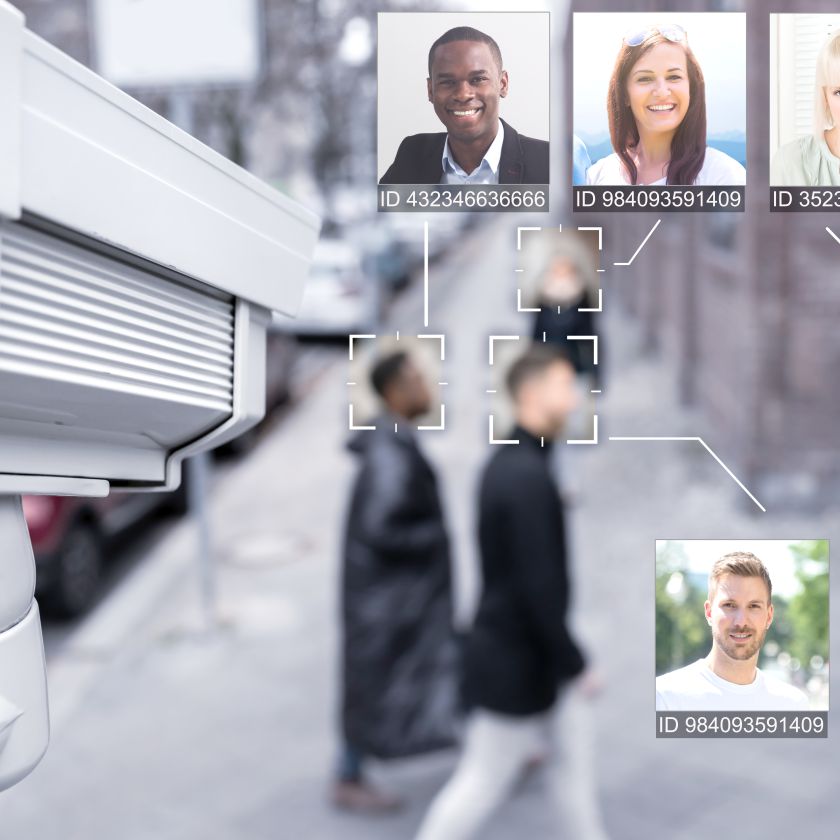
Theft Prevention
Theft prevention applications using computer vision are a robust solution for safeguarding merchandise and enhancing store security. Smart cameras and advanced algorithms detect and deter potential theft incidents in real-time.
Facial recognition identifies individuals entering the store, preventing known shoplifters from re-offending. Object tracking monitors product movement and raises alerts for suspicious behavior. Anomaly detection algorithms analyze customer behavior and raise alarms for unusual actions, such as lingering after hours. These applications create a powerful system to protect retailers from losses and maintain a safe shopping environment.
Facial Recognition
Facial recognition, as a cutting-edge theft prevention application that efficiently identifies potential shoplifters, enhancing store security. This technology captures and analyzes facial features of individuals entering the store, comparing them against a database of known shoplifters or persons of interest.
Quick and Accurate Identification
Facial recognition systems employ advanced algorithms to match facial patterns, enabling quick and accurate identification of individuals with a history of theft or suspicious behavior. Real-time alerts allow store personnel to take immediate action and prevent potential theft incidents.
A Powerful Deterrent
Facial recognition acts as a powerful deterrent, dissuading known shoplifters from targeting the store due to the risk of being recognized and apprehended. This significantly reduces theft instances and protects merchandise.
Streamlining Security Efforts
Facial recognition streamlines security efforts by automating the identification process, reducing reliance on manual monitoring. It enhances the efficiency of store personnel, allowing them to focus on other critical tasks.
Non-Intrusive and Privacy Respecting
Facial recognition offers a non-intrusive approach to theft prevention, as it does not require physical interactions or invasive searches. It respects the privacy of law-abiding customers while maintaining a secure shopping environment.
Data-Driven Security Strategies
The data collected through facial recognition provides valuable insights into theft patterns and trends, allowing retailers to develop proactive security strategies and allocate resources more effectively.
Facial recognition, as a theft prevention application using computer vision in retail, is a game-changer for enhancing store security. With its ability to deter potential thieves, automate identification processes, and optimize security efforts, facial recognition ensures a safer shopping experience for customers and protects retailers from losses due to theft.
Object Tracking
Object tracking offers a sophisticated solution to monitor the movement of products and prevent theft incidents in real-time. This technology utilizes smart cameras and advanced algorithms to track the trajectory of objects within the store.
The system worksby continuously analyzing visual data from the smart cameras, detecting and identifying objects on shelves or in designated areas. If an object deviates from its normal path or is removed from the shelf without authorization, the system raises an alert, notifying store personnel of potential theft.
There are significant benefits of object tracking in theft prevention. Firstly, it provides proactive surveillance, allowing retailers to detect suspicious behavior just as it happens, preventing theft attempts before they escalate.
Secondly, object tracking is efficient and minimizes false alarms. Unlike traditional security systems that rely on motion sensors, object tracking accurately differentiates between legitimate customer interactions and unauthorized removal of merchandise.
Moreover, the real-time alerts generated by object tracking systems enable store personnel to respond promptly to theft incidents. Doing this increases the likelihood of apprehending perpetrators and recovering stolen items.
Object tracking helps retailers optimize store layouts and product placements. By analyzing customer interactions with products, retailers can identify popular items and strategically position high-value products to deter theft.
As a theft prevention application using computer vision, object tracking is a powerful tool forenhancing store security and preventing losses. Its ability to provide real-time monitoring, minimizes false alarms, and optimizes store operations ensuring a safer shopping environment for customers and protecting retailers’ merchandise and assets.
Anomaly Detection
Anomaly detection offers a proactive and intelligent approach to identifying suspicious behaviors and potential theft incidents. The detection technology employs smart cameras and advanced algorithms to continuously monitor customer actions and interactions within the store environment.
Anomaly detection systems establishi baseline patterns of normal customer behavior, such as dwell times, walking paths, and product interactions. Any deviations from these established patterns, such as loitering or unusual movements, will trigger alerts for store personnel, indicating a potential theft or security concern.
It offers real-time monitoring of customer behavior, enabling retailers to respond promptly to potential theft incidents, preventing losses, and maintaining a secure shopping environment. Anomaly detection is adept at identifying subtle and uncommon patterns that may go unnoticed by traditional surveillance methods. By leveraging advanced computer vision algorithms, retailers can detect suspicious behaviors that may otherwise evade human observation.
Moreover, anomaly detection contributes to a proactive approach to security. Instead of reacting to theft after it occurs, retailers can prevent incidents from happening in the first place by intervening as soon as abnormal behaviors are detected.
The data collected through anomaly detection can be used to identify trends and patterns in theft activities. This is great for helping retailers develop more effective and targeted theft prevention strategies.
It also empowers retailers to enhance store security and reduce losses due to theft. Its ability to detect abnormal behaviors in real-time, proactively prevent incidents, and provide valuable insights for security planning ensures a safer and more secure shopping experience for customers while safeguarding retailers’ assets and merchandise.
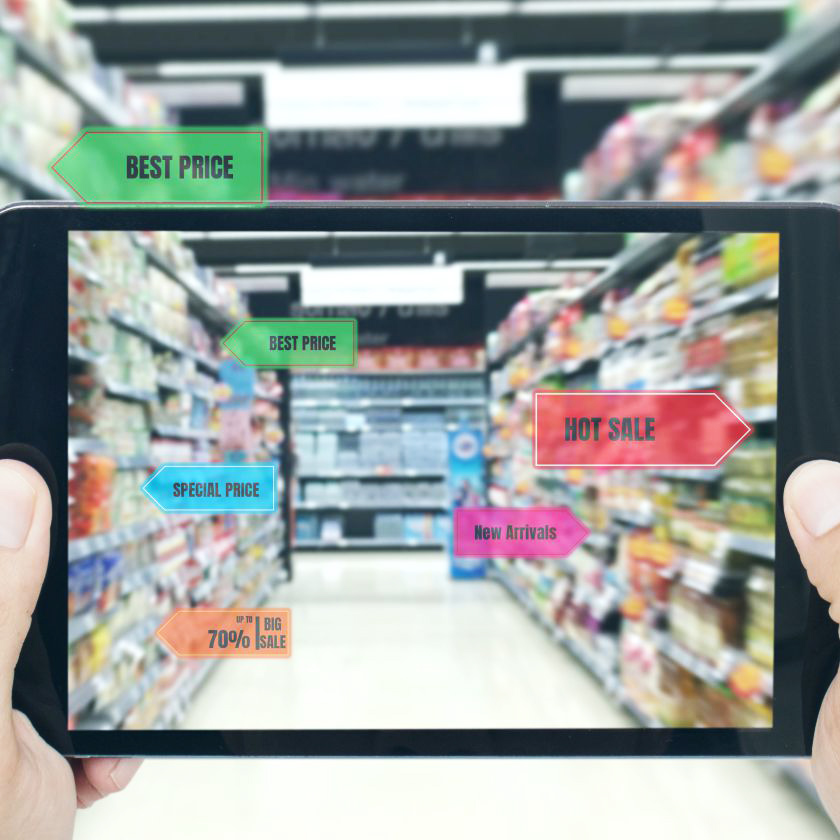
Customer engagement
Customer engagement tools using computer vision in retail leverage cutting-edge technology to create immersive and personalized shopping experiences. These applications enable retailers to connect with customers on a deeper level, enhancing brand loyalty and satisfaction.
Personalized experiences involve analyzing customer data and behavior through computer vision to offer tailored product recommendations and promotions, increasing the likelihood of conversions.
Augmented reality (AR) allows customers to visualize products virtually. For instance, before buying clothes, customers can try them on and be sure that they like the outfit before buying it. Similarly, if they plan on buying furniture, customers can set it up visually to check whether it fits their aesthetic. Such technology can bridge the gap between online and in-store shopping.
Smart dressing rooms utilize computer vision to recognize items customers bring into the fitting room, displaying complementary items or suggesting different sizes and colors, providing a seamless and interactive shopping journey.
Personalized experiences
Using computer vision, personalized experiences in retail can offer a transformative approach to customer engagement, elevating shopping journeys to new heights of customization and satisfaction. This technology leverages smart cameras and advanced algorithms to analyze customer data and behavior, enabling retailers to provide tailored product recommendations and promotions.
Personalized experiences track customer interactions, preferences, and purchase history in real-time. By understanding individual preferences, retailers can curate personalized product suggestions and targeted promotions that align with each customer’s unique interests.
There are many of personalized experiences in customer engagement. It enhances customer satisfaction, as shoppers feel valued and understood when presented with products that resonate with their tastes and needs.
Customizing user experiences boost conversion rates, as customers are more likely to make purchases when presented with products that align with their preferences, leading to increased sales and revenue for retailers.
It also fosters brand loyalty, as customers develop a stronger connection to retailers who provide tailored experiences.
Furthermore, personalized experiences contribute to a seamless and efficient shopping journey, reducing customers’ time and effort searching for products, and streamlining the decision-making process.
Providing personalized experiences using computer vision is game-changing in customer engagement. Retailers can create meaningful connections with their customers by harnessing their data and developing insights for specific recommendations. These meaningful connections drive loyalty, increase sales, and ensure each individual’s delightful and satisfying shopping experience.
Augmented reality
Augmented reality (AR) in retail offers a captivating and immersive customer engagement tool, revolutionizing how shoppers interact with products and brands. This technology, powered by computer vision, overlays digital content onto the real-world environment, enabling customers to visualize and interact with products virtually.
These applications use smart cameras and sensors to detect real-world objects, like clothing, furniture, or accessories. Advanced computer vision algorithms then analyze the visual data and precisely position virtual objects in real-time, allowing customers to view and interact with them through their smartphones or AR devices.
Using AR for customer engagement enhances the shopping experience by allowing customers to try on clothes virtually, visualize furniture in their homes, or see how cosmetics would look on their faces.
AR boosts customer confidence in their purchase decisions, as they can see how products fit or look in their surroundings before committing.
Moreover, AR applications create memorable and shareable experiences for customers, increasing brand awareness and driving social media engagement.
It empowers retailers to stand out from competitors by offering innovative and cutting-edge shopping experiences, attracting tech-savvy customers and enhancing brand perception.
Using computer vision in augmented reality for customer engagement can provide an interactive and immersive shopping experience.By leveraging AR, retailers can increase customer satisfaction, drive sales, and create a unique and unforgettable shopping journey that resonates with modern consumers.
Smart dressing rooms
Smart dressing rooms are an advanced tool that leverages computer vision in retail to enhance the shopping experience and drive customer satisfaction. These technologically advanced fitting rooms incorporate smart cameras and sensors to offer interactive and personalized features for shoppers.
How do smart dressing rooms work? Using computer vision, they can identify the items customers bring in, and then they display complementary items, suggest different sizes or colors, and offer real-time product information on interactive screens tailored to each customer’s preferences and purchase history.
With smart dressing rooms, shopping becomes seamless and interactive, eliminating the need for customers to search for items manually and streamlining the try-on process. By providing personalized recommendations and additional product information, these dressing rooms instill confidence in customers’ purchase decisions, saving both their time and the store personnel’s. This, in turn, optimizes store operations and enhances overall efficiency.
Moreover, smart dressing rooms increase customer engagement and foster brand loyalty by offering an enjoyable and novel interactive experience. With personalized recommendations, real-time information, and interactive features, these fitting rooms create a delightful and satisfying shopping journey, ultimately driving sales and strengthening customer loyalty for retailers.
E-commerce

Computer vision in e-commerce in retail transforms the online shopping landscape by providing innovative applications. Visual search enables customers to find products effortlessly by uploading images as search queries: streamlining the discovery process. Product classification and tagging use computer vision algorithms to automatically categorize items, improving website navigation and enhancing user experience. Quality control applications utilize computer vision to inspect products, ensuring they meet quality standards before shipment, reducing returns and enhancing customer satisfaction. These computer vision advancements revolutionize e-commerce, making it more intuitive, efficient, and visually engaging for customers and retailers.

Visual Search Applications
Visual search applications that use computer vision in e-commerce in retail offer a game-changing approach to product discovery and customer engagement. With the help of advanced image recognition algorithms, these applications allow customers to search for products using images as queries instead of text. Shoppers can snap a picture or upload an image from the web to instantly find similar or visually related products.
Visual search enhances the customer experience by eliminating the need for precise product descriptions, making the search process more intuitive and efficient. It enables customers to find desired items even if they struggle to articulate them in words. Additionally, visual search drives impulse buying as customers encounter visually appealing products during their search.
Visual search applications offer valuable insights into customer preferences and trending products for retailers.By analyzing visual search data, retailers can optimize their product offerings, refine marketing strategies, and improve customer engagement. Overall, visual search revolutionizes e-commerce, transforming how customers interact with online stores and redefining the shopping experience.
Image-Based Search
Image-based search is a powerful component of visual search applications that use computer vision. They offer immense usefulness in transforming how customers discover and interact with products. This technology allows customers to initiate product searches by uploading images or taking photos of desired items, eliminating the need for text-based queries.
The image-based search uses image recognition algorithms to analyze and understand the visual features of the uploaded images. The system then matches these visual features with similar or visually related products in the retailer’s inventory, presenting relevant search results to the customer.
The benefits of image-based search in visual search applications are significant. Firstly, it simplifies the customer search process, making it more intuitive and user-friendly. Shoppers can find desired products without t specific keywords or descriptions, enhancing the overall user experience.
Secondly, image-based search enhances product discovery and recommendation capabilities, driving customer engagement and increasing the likelihood of impulse purchases. Customers can stumble upon visually appealing products during their search, leading to increased retail sales.
Moreover, image-based search provides retailers valuable insights into customer preferences and trending products. By analyzing visual search data, retailers can optimize their product offerings, design targeted marketing campaigns, and personalize the shopping experience.
Image-based search in visual search applications that use computer vision in retail offers a transformative and user-centric approach to product discovery. By leveraging the power of visual recognition, retailers can provide customers with a seamless, engaging, and personalized shopping experience, ultimately driving customer satisfaction and loyalty.
Similar Product Recommendations
Similar product recommendations in visual search applications using computer vision assist to customers in finding products that match their preferences and interests. These recommendations are based on sophisticated algorithms that analyze visual features and characteristics of the searched product, then present a list of visually similar items from the retailer’s inventory.
The process works by leveraging computer vision to extract key visual attributes of the initial search item, such as color, shape, pattern, and style. The system then compares these features with a vast database of products, identifying visually similar items to generate recommendations.
They enhance customer engagement and satisfaction by offering a wider selection of products that align with customer’s tastes and preferences. These recommendations encourage cross-selling and upselling opportunities as customers are introduced to related items they might not have otherwise discovered.
Similar product recommendations increase average order value and overall sales for retailers. Retailers can boost conversion rates and revenue by presenting customers with visually appealing and relevant options. These recommendations enhance the overall user experience, making the shopping journey more personalized and enjoyable for customers.
Similar product recommendations in visual search applications using computer vision in retail play a vital role in guiding customers to discover products that suit their preferences. With enhanced engagement, increased sales, and improved user experience, these recommendations are an invaluable tool for retailers to drive customer satisfaction and business growth.
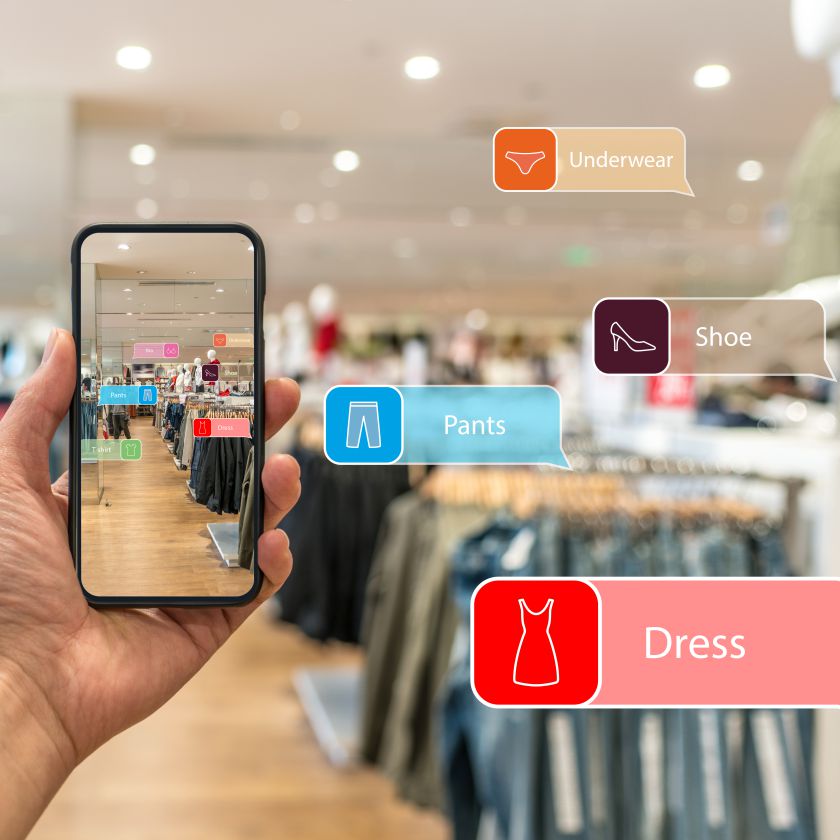
Product Classification and Tagging
Using computer vision for product classification and tagging in e-commerce is a powerful way to organize and manage product inventories efficiently. Automated algorithms analyze visual features like shape, color, and texture to assign categories and tags automatically, making the merchandising process smoother.
Meta-data generation adds relevant information to product images, like brand, size, and material.. This enriches product descriptions and improves search filters, making it easier for customers to find products.
Automated categorization and meta-data generation revolutionize product management, providing accurate categorization and detailed product information. This enhnaces the user experience, making product discovery seamless and intuitive. It also helps retailers optimize product presentation, increase customer engagement, and drive sales.
By using computer vision for product classification and tagging, e-commerce retailers can stay competitive and offer a more personalized and satisfying shopping experience for customers.
Automated Categorization
Automated categorization in product classification and tagging using computer vision revolutionizes how products are organized and presented to customers. This technology employs advanced image recognition algorithms to automatically categorize and tag products based on their visual features, such as color, shape, texture, and patterns.
How Automated Categorization Works
Automated categorization analyzes the visual attributes of each product image and compares them to predefined categories or classes. It then assigns the most suitable category or tag to the product, ensuring accurate and consistent organization.
Substantial Benefits of Automated Categorization
Automated categorization offers significant benefits. It reduces manual labor and time needed to tag and categorize products, streamlining the merchandising process and handling large product inventories efficiently.
Improving Website Navigation and Customer Experience
Automated categorization enhances website navigation and search functionality, allowing customers to find products quickly and easily. This improves the overall customer experience, increasing engagement and satisfaction.
Personalized Recommendations and Tailored Marketing
This technology enables personalized product recommendations and tailored marketing strategies. With accurately categorized and tagged products, retailers can offer relevant suggestions to customers, increasing the likelihood of conversion and repeat purchases.
Consistency and Seamless Shopping Experience
Automated categorization ensures consistency in product organization, reducing confusion for customers and making the shopping experience seamless and intuitive.
Automated categorization in product classification and tagging allows retailers to optimize their product presentation, enhance customer experience, and increase overall operational efficiency. Leveraging advanced image recognition technology, retailers can deliver a more personalized and satisfying shopping journey, driving customer loyalty and business success.
Meta-Data Generation
Meta-data generation in product classification and tagging is a powerful and efficient way to improve product organization and provide valuable information for customers. This technology uses advanced algorithms to extract relevant meta-data from product images, including color, size, material, brand, and more.
How Meta-Data Generation Works
Meta-data generation analyzes visual attributes of each product image and uses computer vision techniques to identify and extract specific information. This data is then associated with the product, enriching its description and improving its discoverability through search filters and navigation.
Enhancing the Shopping Experience
Customers can find products more easily and accurately by using specific search filters, enhancing the overall shopping experience.
Better Product Recommendations
Meta-data generation enhances product recommendation systems by providing detailed information. Retailers can offer more relevant and personalized suggestions to customers, increasing the chances of conversion.
Streamlining Inventory Management
Automatically generating meta-data for new products reduces the manual effort required for data entry and updating, streamlining inventory management.
Improved Product Accessibility and Visibility
Detailed product information helps customers make informed purchasing decisions, increasing their confidence in the products and reducing returns.
Meta-data generation enhances product organization, improves customer experience, and drives sales. By automating the process of generating meta-data, retailers can optimize their product presentation, provide better customer service, and create a more engaging and satisfying shopping journey for customers.

Quality Control
Quality control using computer vision in e-commerce ensures that product images meet high standards before display. Image quality assessment algorithms analyze images for issues like blurriness, lighting, and resolution to ensure clear and visually appealing representations.
Content Moderation
Content moderation algorithms examine product descriptions and reviews to detect and filter inappropriate or harmful content. This helps maintain a safe and family-friendly shopping environment for customers.
Benefits for Retailers and Customers
Computer vision-driven quality control benefits retailers and customers alike. Ensuring enticing and accurate product images reduces the likelihood of customer dissatisfaction and returns. Content moderation guarantees only relevant and appropriate information is presented to customers, enhancing their shopping experience and building trust in the brand.
A Crucial Aspect of Reputable E-commerce Platforms
Quality control using computer vision in e-commerce is essential for maintaining a reputable and successful online retail platform. It ensures that products and images meet the highest standards, providing customers with a safe and satisfying shopping experience.
Image Quality Assessment
Image quality assessment using computer vision in retail is crucial for ensuring product images meet high standards of visual appeal and accuracy. This technology employs advanced algorithms to analyze aspects like blurriness, lighting, resolution, and composition.
The process involves automatically scanning product images and assigning a quality score based on predetermined criteria. Images not meeting the desired quality threshold can be flagged for review or improvement.
It maintains a professional and consistent visual presentation of products, attracting potential customers. Clear and accurate representations of products help customers make informed decisions, increasing trust and confidence in the retailer.
Moreover, it reduces the chances of customer dissatisfaction and returns. High-quality images prevent misleading or subpar representations.
Automated image quality assessment streamlines the quality control process, saving time and resources for retailers.
Overall, it is a valuable tool for maintaining a reputable e-commerce platform, enhancing customer satisfaction, building trust, and driving sales.
Content Moderation
Content moderation using computer vision is crucial for maintaining a safe and family-friendly online shopping environment. This technology automatically detects and filters inappropriate or harmful content, like offensive language, explicit images, or prohibited items in product descriptions and reviews.
The process involves scanning and analyzing text and images associated with product listings and user-generated content. Algorithms compare the content against a database of known prohibited content and predefined guidelines to identify violations.
Content moderation ensures platform compliance with regulations and guidelines, reducing legal risks and reputational damage. It fosters a positive user experience by protecting customers from encountering harmful or offensive content.
This technology builds a reputable brand image and fosters customer trust. By curating a clean shopping environment, retailers can drive repeat business and build a loyal customer base.
Automated content moderation streamlines quality control by reviewing and filtering large volumes of user-generated content. It saves time and resources, allowing retailers to focus on other e-commerce operations.
In conclusion, content moderation using computer vision is crucial for maintaining a reputable online platform. By providing a safe and positive user experience, retailers enhance customer satisfaction, protect their brand, and create a trustworthy shopping environment.
Challenges and Ethical Considerations

Computer vision in retail faces various challenges and ethical considerations that need careful attention for responsible deployment.
The collection and use of visual data raise privacy concerns, necessitating proper data protection measures and customer consent to ensure data is handled responsibly.
Algorithms and tagging may introduce bias, leading to inaccurate product categorization and potentially perpetuating discriminatory practices. Ensuring fairness and transparency in algorithms is vital.
Computer vision systems may have limitations that affect accuracy and performance. Continuous improvements and testing are necessary to minimize errors.
Balancing the benefits of computer vision with addressing ethical considerations is crucial for responsible and sustainable deployment in the retail industry. Retailers must navigate these challenges to ensure ethical and effective use of this technology.
Privacy Concerns
Privacy concerns in using computer vision in retail arise from the collecting, storing, and analyzing visual data, including customers’ images and behavior. To address these concerns responsibly, retailers must prioritize transparency and consent.
Transparency and Consent
Retailers should provide clear and accessible privacy policies, informing customers about data collection purposes, usage, and protection measures. Obtaining explicit consent from customers before capturing and using their visual data is essential.
Robust Security Measures
Implementing strong security measures, such as encryption, access controls, and regular security audits, helps safeguard collected data and minimize the risk of breaches.
Anonymization and Data Minimization
Retailers should avoid collecting unnecessary data and ensure collected data cannot be linked back to specific individuals whenever possible.
Compliance with Data Protection Laws
Retailers must adhere to relevant data protection laws and regulations, handling visual data lawfully and ethically.
By fostering trust with customers through these practices, retailers can responsibly use computer vision, harnessing its benefits while respecting individuals’ privacy and data protection rights in the retail industry.
Bias in Algorithms
Bias in algorithms used in computer vision refers to unfair or discriminatory outcomes resulting from biased data or flawed decision-making processes. Biases can lead to inaccurate product categorization, biased search results, and discriminatory recommendations, negatively impacting customer experiences and perpetuating unfair practices.
Addressing Bias Responsibly
Retailers must focus on data quality and diversity to approach bias responsibly. Ensuring training data represents the diverse customer base is essential. This involves seeking out diverse datasets and removing any biased or discriminatory elements.
Prioritizing Fairness and Transparency
Retailers should design algorithms with fairness and transparency in mind. Regularly testing and evaluating algorithms for bias and making necessary adjustments ensures equitable outcomes.
Inclusive Development and Testing
Involving a diverse team in algorithm development and testing can help identify and address potential biases from different perspectives.
Regular Monitoring and Auditing
Regularly monitoring algorithms’ performance catches biases that may arise over time due to changes in data or practices.
By proactively addressing bias, retailers ensure their computer vision systems provide fair and accurate results, fostering trust and promoting an inclusive and equitable shopping experience for all customers.
Technological Limitations
Technological limitations in using computer vision in retail refer to the challenges and constraints that can affect the accuracy, performance, and scalability of computer vision systems. Some common limitations include:
- Image Quality. Computer vision algorithms heavily rely on the quality of input images. Poor lighting, blurriness, or low-resolution images can lead to inaccurate results.
- Real-time Processing. Real-time processing of large volumes of data can be computationally intensive, potentially leading to delays in generating responses.
- Occlusion and Variability. Objects may be partially obscured or appear in different positions and orientations, making it challenging for algorithms to recognize them accurately.
- Scalability. As the number of products and images in a retail system grows, scalability becomes a concern, requiring robust infrastructure and algorithms.
Overcoming Technological Limitations
To address these technological limitations, retailers should focus on continuous improvement and adaptation. This involves investing in advanced hardware and software to optimize processing speed and efficiency.
Regular Algorithm Updates
Frequent updates and enhancements to algorithms are necessary to improve accuracy and tackle real-world challenges like occlusion and variability.
Leveraging Cloud-Based Solutions
Exploring cloud-based solutions allows retailers to harness the scalability and computing power of cloud platforms for handling large volumes of data.
Partnerships and Research
Forming partnerships with technology experts and engaging in ongoing research in computer vision keeps retailers at the forefront of technological advancements.
By embracing innovation, addressing limitations, and being open to learning and adaptation, retailers can unlock computer vision’s potential to enhance the shopping experience, improve efficiency, and drive business success in the retail industry.
Case Studies
Computer vision has emerged as a transformative technology in the retail industry, changing how customers shop and how retailers operate. The following case studies explore three pioneering examples of computer vision in the retail sector.
Each study showcases the unique applications, benefits, and challenges, revealing how computer vision enhances shopping, streamlines operations, and boosts customer engagement. These real-world examples provide valuable insights into the potential and impact of computer vision on the future of retail.
Amazon Go The Amazon Go case study showcases the groundbreaking use of computer vision in retail. | Zara's Smart Dressing Room Zara's smart dressing rooms case study illustrates the transformative power of computer vision in retail | Merchandising Automation with Goods Checker The Goods Checker case study demonstrates how computer vision can revolutionize planogram creation and implementation in retail. | |
|---|---|---|---|
Goal | The goal was to create a seamless shopping experience by eliminating checkout lines and cashiers. Amazon achieved ths by deploying cameras, sensors, and advanced computer vision algorithms throughout the store. | The aim was to enhance customer engagement and streamline the try-on process in physical stores. To achieve this, Zara introduced interactive mirrors with computer vision technology in their dressing rooms. | The challenge was to streamline the process of creating planograms and efficiently compare them to realograms for compliance and shelf space optimization. |
Solution | Using computer vision, the system tracks customers as they enter, identify the items they pick up, and add them to their virtual cart. It also removes items if customers put them back. When customers leave, the system calculates the total bill and processes payment through their Amazon account. | The solution included integrating cameras and sensors into the dressing room mirrors, enabling customers to interact with the technology. As customers enter with selected items, the computer vision system automatically detects the products and displays additional information, such as alternative colors and sizes, on the mirror. Customers can also request assistance or recommendations through the mirror interface. | The solution involved deploying computer vision algorithms to analyze product images and identify items on shelves. Digital planograms were created based on the detected products, allowing retailers to visualize the optimal shelf layout before implementation. To compare planograms to realograms, Goods Checker uses computer vision to capture real-time shelf images of store shelves and compare them to the digital planograms. Discrepancies, such as misplaced items, were detected, enabling retailers to make data-driven adjustments for improved shelf efficiency and product visibility. |
Results | Amazon Go’s results have been astounding. Customers enjoy the convenience of "just walk out" shopping, saving time and experiencing a frictionless checkout. Other retailers are inspired, shwoing increased interest in adopting similar computer vision technologies. However, the case study also highlights challenges, like setting up and maintaining the complex system and addressing privacy concerns from extensive surveillance camera use. Nonetheless, Amazon Go demonstrates how computer vision can revolutionize the retail industry. | The results of Zara's smart dressing rooms have been highly positive. Customers appreciate the personalized and interactive experience, making the try-on process more efficient and enjoyable. The technology also provides valuable insights into customer preferences and behavior, helping the company optimize its product offerings and marketing strategies. The case study emphasizes the importance of addressing potential privacy concerns related to the use of cameras in dressing rooms. Zara ensured transparency and customer consent to address these concerns. Zara's smart dressing rooms showcase how computer vision can revolutionize the shopping experience in physical stores, bridging the gap between online and offline retail and creating innovative, customer-centric solutions. | The results of Goods Checker have been impactful, with increased shelf compliance, leading to better product organization, reduced out-of-stocks, and improved customer experience. Real-time monitoring helped retailers respond quickly to shelf changes, ensuring an efficient and visually appealing shopping environment. The case study emphasizes continuous improvement and customization to address specific retail needs and adapt to changing product assortments. Goods Checker showcases how computer vision optimizes planogram creation and implementation, streamlining retail operations and driving greater sales and customer satisfaction. |
Importance of Staying Ahead in a Competitive Market
In today’s competitive retail market, adopting computer vision technology is crucial for staying ahead and driving business growth. This powerful tool enhances customer engagement by offering personalized experiences, seamless visual search, and interactive applications in stores.
Computer vision also streamlines inventory management, reducing stockouts, optimizing shelf space, and improving operational efficiency. This results in cost savings and competitive pricing.
By using computer vision for data-driven decision-making, retailers gain valuable insights into customer preferences and emerging trends, enabling quick adaptation to market demands.
Embracing computer vision positions retailers as industry innovators, attracting new customers and fostering brand loyalty.
In a competitive market, computer vision is not just an option but a necessity for sustained success. It empowers retailers to provide exceptional experiences, optimize operations, and make informed decisions, securing a strong position in the retail landscape and driving long-term success.
Opportunities for Growth and Innovation
Opportunities for growth and innovation in computer vision in retail are abundant, offering retailers new and exciting ways to enhance the shopping experience, streamline operations, and drive business success.
Visual search applications present a significant opportunity for growth, allowing customers to find products using images as search queries, making product discovery more intuitive and efficient.
Personalized experiences using computer vision can enable retailers to offer tailored product recommendations, customized marketing, and individualized shopping journeys, fostering customer loyalty and satisfaction.
Computer vision in inventory management offers opportunities for retailers to optimize stock levels, reduce out-of-stocks, and improve shelf organization through planogram creation and real-time monitoring.
In-store applications, such as smart dressing rooms with interactive mirrors, provide retailers with opportunities to engage customers, offer virtual try-ons, and gather valuable insights into customer preferences and behaviors.
Content moderation using computer vision ensures a safe and secure shopping environment by filtering out inappropriate content and protecting customers from harmful material.
As computer vision technology continues to advance, there is vast potential for innovation in areas like cashierless stores, automated checkout processes, and real-time customer analytics.
Retailers can also explore partnerships with technology providers and startups to leverage cutting-edge computer vision solutions tailored to their specific needs.
Overall, the opportunities for growth and innovation in computer vision in retail are vast, presenting retailers with the tools to create personalized, efficient, and immersive shopping experiences that resonate with modern consumers.
Recap of the Impact of Computer Vision
Computer vision has had a profound impact on the retail industry, transforming various aspects of the shopping experience and revolutionizing how retailers operate. Firstly, computer vision has greatly improved inventory management, automating the process of stock counting, real-time monitoring, and optimizing shelf space utilization. This has led to reduced stockouts, minimized overstock situations, and increased operational efficiency.
Secondly, in-store applications of computer vision, such as smart dressing rooms and interactive mirrors, have enhanced customer engagement by providing personalized experiences, virtual try-ons, and product recommendations. These technologies bridge the gap between online and offline shopping, creating a seamless and interactive journey for customers.
Visual search and product classification using computer vision have made product discovery more efficient and intuitive, allowing customers to find products through images and enhancing their overall shopping experience.
Computer vision-based content moderation has ensured a safe and family-friendly shopping environment, protecting customers from encountering inappropriate or harmful content.
In conclusion, computer vision’s impact on retail has been transformative, reshaping traditional retail practices and elevating the shopping experience for both customers and retailers. As technology continues to advance, the potential of computer vision in retail remains limitless, promising further innovations and continued evolution in this dynamic industry.
Conclusion

Computer vision has become a game-changer in retail, transforming how customers shop and retailers operate. Its benefits, such as improved inventory management and personalized experiences, have revolutionized the industry. By leveraging advanced algorithms and visual recognition technology, retailers have streamlined processes and delivered seamless shopping experiences. As technology continues to evolve, computer vision’s potential in retail is limitless, promising more innovation and exciting developments in the future.


